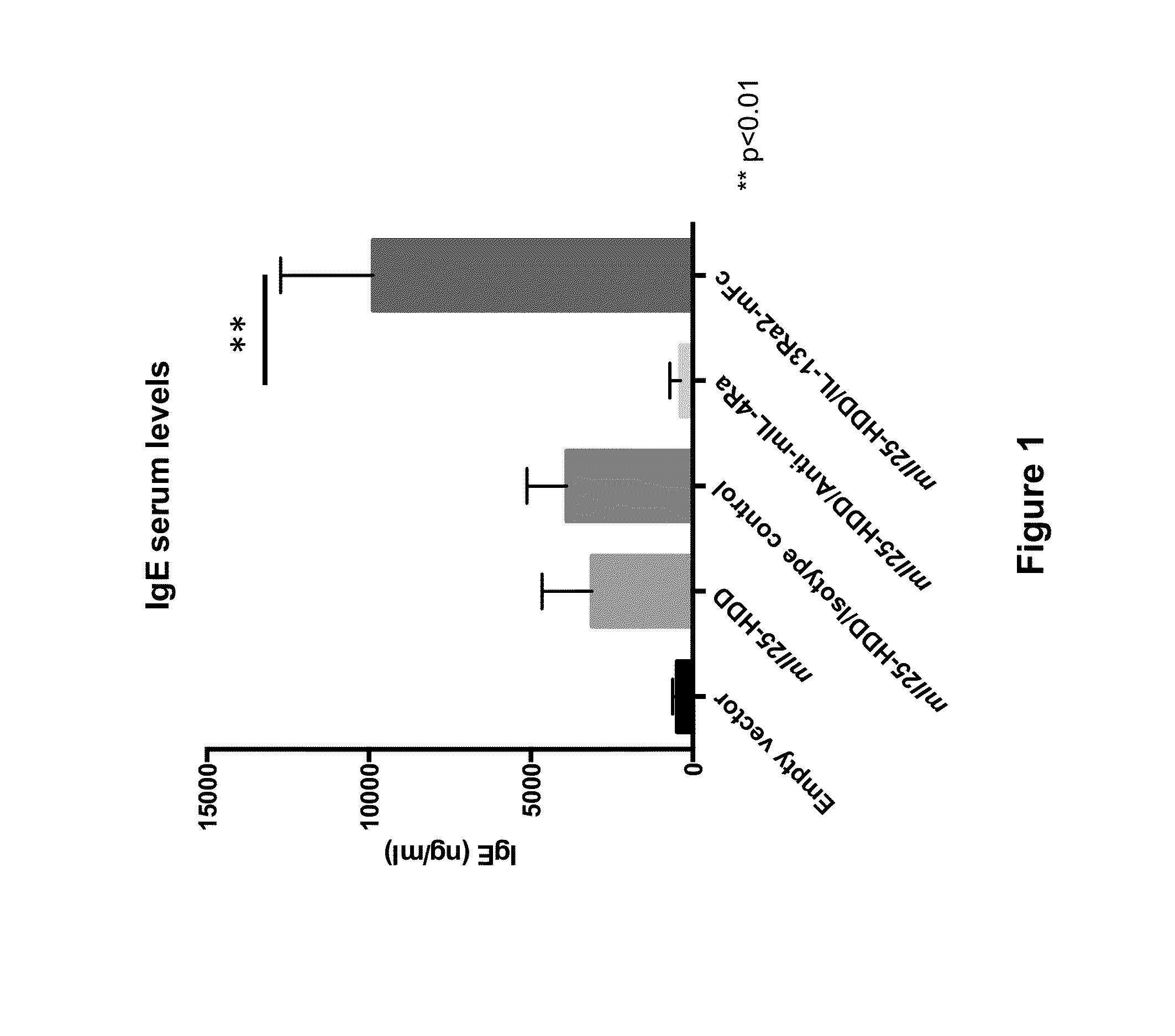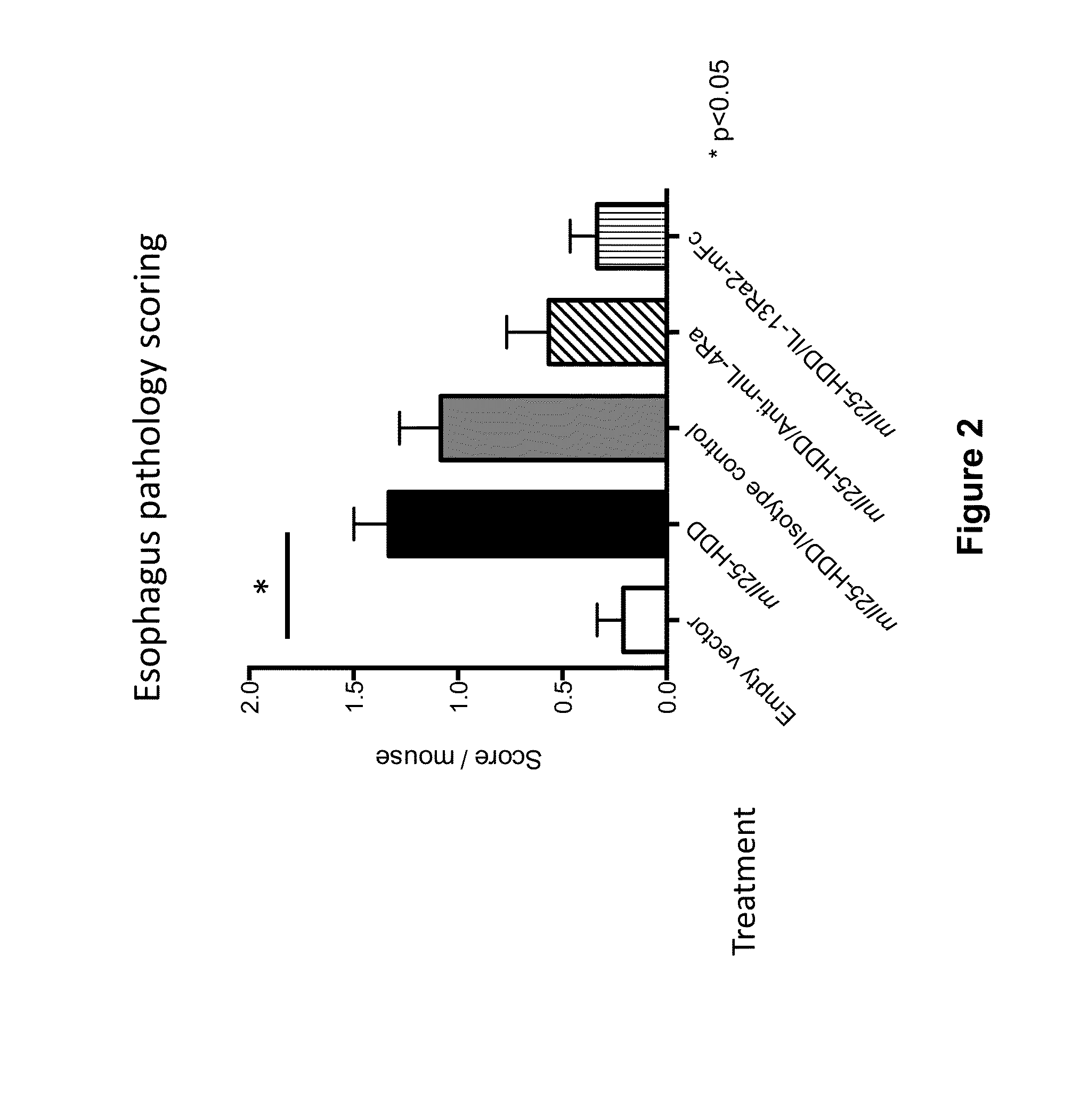Methods for treating eosinophilic esophagitis by administering an IL-4R inhibitor
a technology of eosinophilic esophagitis and inhibitor, which is applied in the direction of antibody medical ingredients, drug compositions, immunological disorders, etc., can solve the problems of affecting the quality of life, the treatment options are currently limited to allergen withdrawal, diet modification and corticosteroids, etc., to reduce the eosinophil infiltration of the esophagus, and reduce the number of eosinophils
- Summary
- Abstract
- Description
- Claims
- Application Information
AI Technical Summary
Benefits of technology
Problems solved by technology
Method used
Image
Examples
example 1
Anti-IL-4R Antibody Reduces Eosinophilic Esophagitis in an IL-25-Hydrodynamic DNA Delivery (HDD)-Driven Mouse Model
[0071]In this Example, the effect of IL-4Rα blockade on eosinophilic esophagitis in an II25-hydrodynamic DNA delivery (HDD) mouse model was assessed. This model is based on the observation that induced IL-25 expression causes IL-13 signaling via the IL-4Rα / IL-13R heterodimer receptor, and consequently results in eosinophilia of the gastrointestinal tract, including eosinophilic infiltration of the esophagus and mucus production.
[0072]On Day 0, Balb / c mice were injected with either a plasmid expressing mouse IL25 DNA (“pRG977 / m II25,” n=17), or an empty vector (“pRG977,” n=4), each at 25 pg of DNA / mouse by the hydrodynamic DNA delivery (HDD) method (see, e.g., Liu et al. 1999, Gene Therapy 6:1258-1266). The plasmid was diluted in PBS and was injected at a high volume (10% of body weight [ml]), and a high injection rate (6-8 seconds per injection) into the tail vein. Mice...
example 2
Anti-IL-4R Antibody Reduces Eosinophilic Infiltration of Esophagus in a Mouse Model of Peanut Allergy
[0080]In this Example, the effect of IL-4Rα blockade on peanut allergen-induced eosinophilic esophagitis in a mouse model was assessed.
[0081]Balb / c mice were sensitized with 200 pg of peanut allergen extract (PAE) in 1 mg of aluminum salts (Alum) adjuvant on day 0 and day 14. Three weeks later, on day 21, mice were challenged intra-nasally with 100 pg of PAE dissolved in 50 μl of phosphate-buffered saline (PBS). The challenge was repeated on day 24, 27 and 30. Starting day 21, one group of challenged mice was not treated and two groups were injected with either anti-IL-4R antibody (“anti-mIL-4R mAb” as described above) at dose 25 mg / kg, or isotype control IgG1. The treatment was applied twice a week, starting day 21. Mice were euthanized 24 hours after the last challenge with PEA on day 31, blood samples and esophagi were collected.
[0082]Esophagi were fixed in buffered formalin, para...
example 3
Clinical Trial of Subcutaneously Administered Dupilumab in Adult Patients with Eosinophilic Esophagitis (EoE)
[0087]This study is a 32-week, double-blind, randomized, placebo-controlled study to investigate the efficacy, safety, tolerability and immunogenicity of dupilumab in adult patients with EoE. Dupilumab is a fully human anti-IL-4R antibody comprising a heavy chain comprising the amino acid sequence of SEQ ID NO: 13 and a light chain comprising the amino acid sequence of SEQ ID NO: 14; an HCVR / LCVR amino acid sequence pair comprising SEQ ID NOs: 1 / 2; and heavy and light chain CDR sequences comprising SEQ ID NOs: 3-8.
[0088]Study treatment is administered for up to 12 weeks with 16 weeks of safety follow-up. After providing informed consent, eligibility is assessed at the screening visit conducted within 4 weeks of the Day 1 baseline visit. Straumann Dysphagia Instrument (SDI) (0-9) symptom diary data (1 week recall period) and EoE Activity Index (EoEAI) symptom diary data (1 wee...
PUM
 Login to View More
Login to View More Abstract
Description
Claims
Application Information
 Login to View More
Login to View More - R&D
- Intellectual Property
- Life Sciences
- Materials
- Tech Scout
- Unparalleled Data Quality
- Higher Quality Content
- 60% Fewer Hallucinations
Browse by: Latest US Patents, China's latest patents, Technical Efficacy Thesaurus, Application Domain, Technology Topic, Popular Technical Reports.
© 2025 PatSnap. All rights reserved.Legal|Privacy policy|Modern Slavery Act Transparency Statement|Sitemap|About US| Contact US: help@patsnap.com



